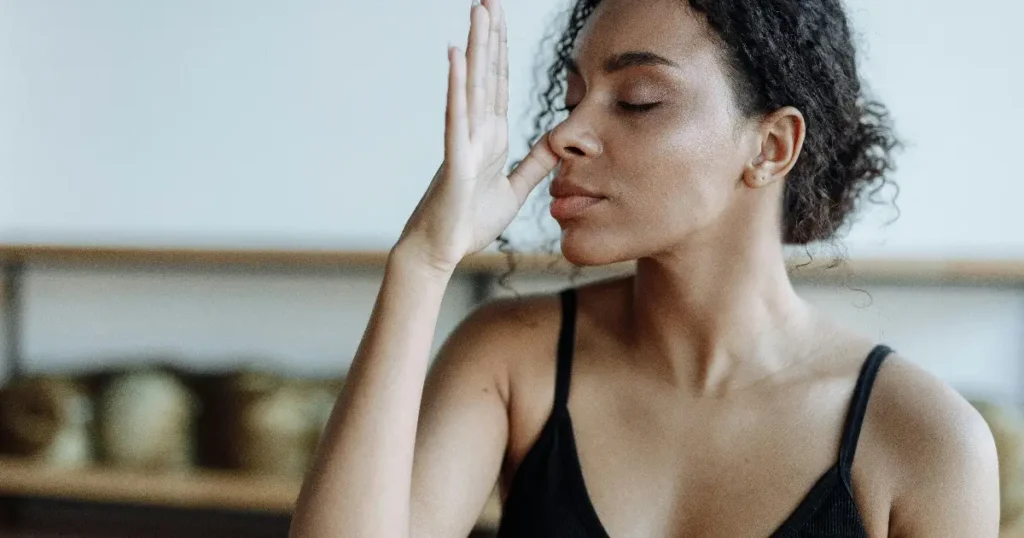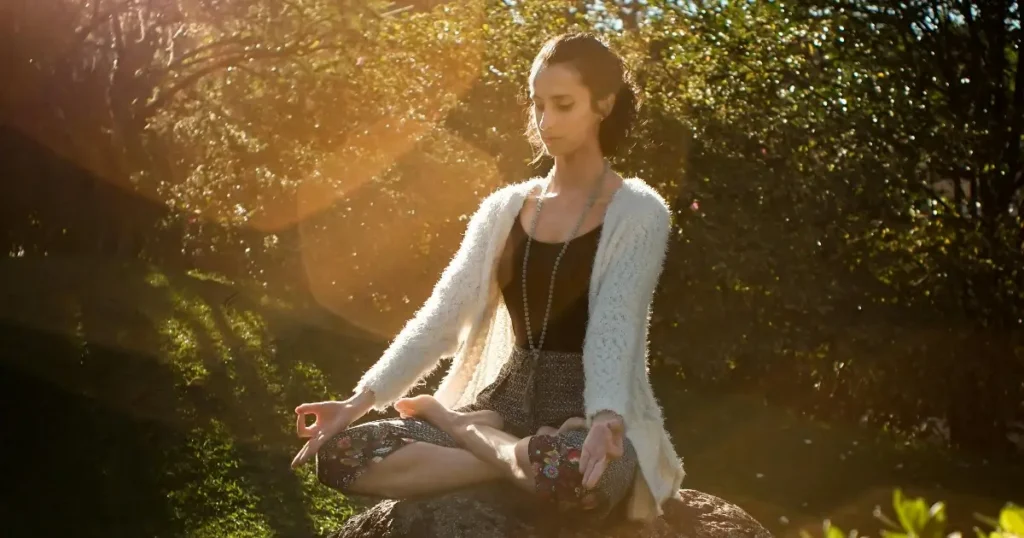Deep Dive into Calm: 8 Deep Breathing Techniques for Meditation

Deep breathing in meditation refers to a conscious and intentional practice of breathing deeply and slowly to promote relaxation, mindfulness, and a sense of calm.
It is a fundamental component of many meditation techniques and is often used as a focal point to anchor the mind in the present moment. Deep breathing involves paying attention to the breath, inhaling and exhaling in a deliberate and controlled manner.
When practiced diligently, this form of meditation acts as a gentle yet potent tool. It opens a gateway to a tranquil state of mind, aids in reducing stress and anxiety, sharpens focus and concentration, and most importantly, fosters an enhanced sense of overall well-being.
There is a rich tapestry of deep breathing meditation techniques, each bringing its distinctive style and potential benefits.
Let’s learn more.
1. Diaphragmatic Breathing (or Abdominal Breathing)

Diaphragmatic breathing, also known as abdominal breathing, is a form of deep breathing that involves full engagement of the diaphragm, a dome-shaped muscle located beneath the lungs.
This technique encourages maximum intake of oxygen into the body, enhancing overall respiratory efficiency. When practicing diaphragmatic breathing, the focus is on making the abdomen, rather than the chest, rise and fall with each breath.
To initiate, place one hand on your chest and the other on your abdomen. As you inhale deeply through the nose, aim to draw the breath in such a way that the hand on your abdomen rises higher than the one on your chest.
This signifies that the diaphragm is pulling in maximum air. On exhalation, allow the belly to contract inward, expelling the air out. The act of channeling your breath into the lower parts of the lungs in this manner results in a calming effect, reducing stress and aiding in better focus and relaxation.
Over time, diaphragmatic breathing can help you develop a more mindful, serene, and healthy relationship with your breath.
2. 4-7-8 Breathing

The 4-7-8 breathing technique, often known as “relaxing breath,” is a simple yet powerful method to induce calm and tranquility. It’s all about tuning into the rhythm of your breath and using it as an anchor to still your mind.
Here’s how it works: close your eyes and inhale quietly through your nose for a count of four. Then, hold your breath for a count of seven. Following that, exhale completely through your mouth to a count of eight.
This cycle forms one breath. Repeat the cycle for a total of four breaths. The specific time spent on each phase of breathing isn’t as important as the ratio of 4:7:8, which is key to this practice.
The technique slows down your breathing rate, calms the nervous system, and can even aid in falling asleep faster. It’s a quick and easy method to incorporate into your daily routine, providing a brief mental retreat anytime, anywhere.
The beauty of the 4-7-8 breathing technique is in its simplicity and the peace it brings, one breath at a time.
3. Box Breathing (or Square Breathing)

Box Breathing, also known as Square Breathing, is a powerful, yet simple, deep breathing meditation technique that can help to bring calmness and balance to the mind and body. It works by dividing the breath into four equal parts, similar to the four sides of a box.
The process starts with a slow inhalation for a count of four, filling your lungs with air. The next step is to hold your breath for another count of four, allowing the oxygen to be fully absorbed. You then exhale slowly for a count of four, releasing all the air from your lungs.
The final step is to hold your breath once more for a count of four, before starting the cycle anew. This method can be practiced anytime, anywhere, making it a readily accessible tool for managing stress and anxiety.
Box breathing not only calms the mind but also enhances focus and performance, which is why it’s a favored technique among high-performing individuals. Remember, the effectiveness of this technique lies in the consistency of practice.
Start with a few minutes a day, and gradually increase as you get comfortable.
4. Alternate Nostril Breathing (Nadi Shodhana)

Alternate Nostril Breathing, known in Sanskrit as Nadi Shodhana, is an ancient deep breathing technique originating from yogic traditions. The term Nadi Shodhana translates to ‘clearing the channels of circulation.’
As the name suggests, this method involves alternating the nostrils for inhalation and exhalation, creating a rhythm of breath that soothes the mind. It begins by exhaling completely, then inhaling through the left nostril.
Following this, you hold your breath for a moment, close the left nostril and exhale through the right nostril. This cycle continues as you then inhale through the right nostril, close it, and exhale through the left.
Repeated over several cycles, Nadi Shodhana has a calming and balancing effect on the nervous system, reduces stress and anxiety, and promotes mental clarity.
Often integrated into yoga and meditation practices, this technique also stimulates the vital energy flow in the body, contributing to overall well-being. As you cultivate this practice, visualize each breath you take as a step towards inner equilibrium and tranquility.
5. Mindful Breath Counting

Mindful breath counting is a simple yet profound technique that intertwines mindfulness with your breath. It involves focusing your attention on your breath while mentally counting each exhalation.
It typically starts at one and goes up to ten before resetting back to one. This method is often lauded for its simplicity and effectiveness in harnessing the mind’s wandering nature. As you count, you create a point of focus, helping you stay anchored in the present moment.
When your mind drifts away, which is quite natural, the numbers serve as gentle reminders to guide your attention back to your breath. Not only does this practice promote greater focus and concentration, but it also introduces a calming rhythm to your breath, enhancing relaxation.
This beautiful mix of mindfulness and breathing can act as a powerful tool in your meditation toolkit, helping you cultivate tranquility and clarity amidst the ebbs and flows of life.
Remember, the goal isn’t to reach ten but to be present with each breath, each count.
Embrace the journey, not just the destination.
6. Balloon Breathing with Visualization

Balloon breathing with visualization integrates the power of deep diaphragmatic breathing with the evocative imagery of visualization. It’s a harmonious blend of both physical and mental focus.
To start, place one hand on your chest and the other on your belly. As you take a deep breath in, imagine a balloon in your belly inflating. Feel the rise of your abdomen rather than your chest. As you exhale, visualize the balloon deflating.
Your belly falls; the hand on your chest remains still. This technique encourages full oxygen exchange, promoting relaxation and grounding. Now, add a layer of visualization. With each inhale, picture tranquility as a color or light filling the balloon.
As you exhale, imagine stress and tension leaving your body. This approach not only enhances your focus on the breath but also provides a tangible image to associate with the emotions of calmness and release.
This technique can be a beautiful journey of turning inwards, with your breath and imagery as guides to inner peace.
7. Ocean Breath (Ujjayi Breathing)

The Ocean Breath, or Ujjayi Breathing, is a yogic breathing technique that can provide a profound sense of tranquility. It’s named for the soothing ocean-like sound created during the practice.
To perform this, you need to slightly constrict the back of your throat while breathing in and out through the nose. This gives your breath a gentle, rhythmic whisper.
As you breathe, visualize your breath as waves in an ocean, rising and falling with each inhalation and exhalation. Ujjayi breathing is a powerful method to enhance concentration and focus during meditation.
Not only does it regulate your breathing, but the steady rhythm also guides your mind to stay in the present moment. The sound created acts as an auditory feedback loop, allowing you to notice when your mind wanders and gently guide it back.
Furthermore, Ujjayi breathing warms the body from the inside, making it an excellent technique to incorporate into your yoga practice. It creates a bridge between the body and mind, forging a pathway to mindful living.
Start by practicing Ujjayi breathing for a few minutes each day, and gradually increase the duration as your comfort with the technique grows.
8. Lion’s Breath

Lion’s Breath, also known as Simhasana Pranayama in Sanskrit, is a vibrant and distinctive deep breathing meditation technique that encourages tension release and mind rejuvenation.
Drawing inspiration from the fierce and majestic lion, this technique involves an open-mouthed, extended exhale with a pronounced “ha” sound, much like a lion’s roar.
The act of roaring is liberating and can be a cathartic release of pent-up stress, emotions, or anxiety. As you practice Lion’s Breath, you consciously engage the muscles in your face and throat, promoting better blood circulation and relieving strain in these areas.
Moreover, it also stimulates your diaphragm and aids in respiratory health. This technique can serve as a refreshing break from the quiet tranquility of other breathing exercises. It’s an embodiment of power, strength, and fearlessness – qualities of a lion that you can harness within yourself.
The Lion’s Breath, while intense, can indeed be an empowering addition to your meditative journey, creating a dynamic balance between tranquility and spirited energy.
Final Thoughts

Embracing deep breathing meditation is a powerful step towards a calmer, more centered self. With each inhalation and exhalation, you’re not just nurturing a deeper connection with your inner world, but also developing resilience to navigate life’s stressors.
Take time to explore and practice the techniques shared above. Remember, this is a journey of self-discovery and personal growth. The goal isn’t perfection, but mindfulness, acceptance, and self-compassion.
Happy breathing, and may you discover the tranquility you seek in the sacred rhythm of your breath.





